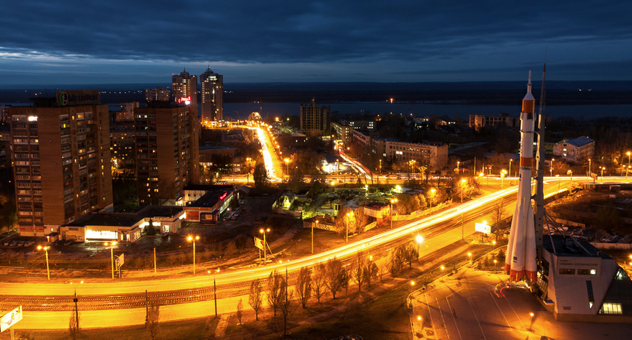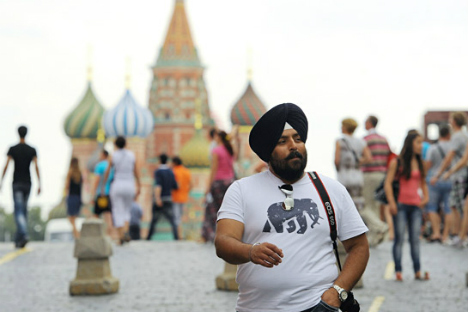A Weekend in Samara: More than beer and football

Samara is often known as Russian Chicago. Both towns have similar climate, topography and branches of industry. Source: Igor Stepanov
There are two kinds of travellers who regularly beat the thousand-kilometre path from Moscow to Samara. The first are football fans following their teams for away matches. The others are fans of singer-songwriters and rock music on their way to the annual ‘Woodstocks’ – ‘The Grushin Festival’ and ‘Rock nad Volgoy.’
View A weekend in Samara: the beer capital of Russia in a larger map
Could it be that the most authentic tourist updates on this city are to be heard from the burly guys in Umbro-hooded sweaters, or the bearded travellers lugging guitar-cases? They acted as guides for our correspondent and showed him the other, real side of Samara.
Saturday
11am – A view of the Volga
Samara is situated on the banks of the River Volga, or as Russian folklore tradition would have it, Mother Volga. As far as inhabitants of the central Russia are concerned, it’s the country’s main river. The main bank of the river hems neatly around Samara. The river embankment runs for more than five kilometres, so you can take a two-hour walk in case you’re in the mood. To get the full feeling of ‘Rock nad Volgoy,’ you can put some suitable modern Russian music on your mp3 player. Treat yourself to a cup of coffee (about 105 rupees) at one of the many local cafes along the way.
12am – A walk in the park
You can end your leisurely amble along Samara’s river-banks with a visit to the Strukovsky Garden, one of the city’s most recognised attractions for visitors. Even well-known society rebels like football supporters and rock-music fans have been known to enjoy the garden too.
12am – Stalin’s Bunker
It’s worth keeping any talk of revolt against the system to a hushed whisper – just a few steps from Strukovsky Garden is Stalin’s Bunker, which used to be an official secret, but now a big hit with city visitors. As is usually the case with this kind of construction, the entrance to it is suitably inconspicuous, and you may need to search around a little. A clue for seekers of the holy of holies – the bunker is underneath the modern Academy of Arts and Culture building, behind a barely noticeable door in the building’s courtyard.
The bunker was built during the Second World War, and even now remains one of the deepest and most impregnable of such underground complexes. The shelter itself is 37 metres below ground – equivalent to the height of a 12-storey building. To put this in context, Hitler’s bunker in Berlin was only equal to a five-storey building, whereas Churchill and Roosevelt would have been just two storeys underground.
The bunker was equipped with its own air-recycling and power supplies. The complex is still kept in a state of operational readiness, and could shelter its inhabitants for up to five days.
Tickets cost approximately 140 rupees.
3pm - Bolshevik beer
You’ll probably be feeling peckish after emerging from subterranean Samara, and here the name of one of Samara’s city symbols quickly comes to mind – the city brewery. In Soviet times, the brewery produced the country’s most popular beer, Zhigulevskoye. Dozens of breweries throughout the USSR produced this beer, but Samara locals remain convinced that only theirs is the real thing.
You can enjoy a tasting of the pride of Soviet beer-making in the brewery’s restaurant, located in one of the oldest buildings in the complex (located at number 4 Volzhsky prospekt). The signboards outside have a peculiarly un-Soviet appearance, reading “U Vakano” in Russian. The waiters at the restaurant will soon tell you that this name derives from the brewery’s original founder, an Austrian named Alfred von Vacano, who was the first to bring the art of brewing beer to Samara.
The menu consists of traditional beer hall favourite dishes from Germany, the Mediterranean and the Czech Republic, alongside Russian classics such as Suvorovsky soup, hotpot and a wide selection of fish dishes cooked with locally caught Volga fish. Anyone who orders the roast leg of pork gets a litre of beer thrown in for free. Prices range from 1050 rupees to 3150 rupees.
5pm – The Lower Depths
Even so, if only for experiment’s sake, it’s worth making a visit to a restaurant full of local atmosphere – The Lower Depths (located at the same address, number 4 Volzhsky prospekt). When local football team Krylya Sovetov (‘Soviet Wings’) is playing, spectators coming from other Russian cities will usually commence their trip to Metallurg Stadium by setting out from this remarkable eatery. Here you’ll find football flags, chants and a river of Zhigulevskoye beer.
And when we say a river of beer, we’re not joking. Beer is piped directly into the bar from the brewery above, so you need have no fears about either its freshness or it running out. Half a litre of beer costs 105 rupees. However, only those not deterred by the rather unkempt appearance of the establishment will be able to check this out for themselves.
Locally caught fish of all possible kinds and styles is served with the beer – Caspian roach, sabre-fish, sturgeon, Azov roach, freshwater whitefish, bream, rudd and pike. Pride of place goes to the Soviet favourite, crayfish.
7pm – Metallurg Stadium
There’s almost nowhere you’ll feel the atmosphere of the ‘beer capital of Russia’ more profoundly than at Metallurg Stadium. Don’t be surprised if you’re dragged along with the local fan brigade to the soccer stadium to cheer for the local ‘Wings’, as the Samara fans call their home team. The main thing is to pick the date of your trip carefully. The stadium is at number 1 ulitsa Stroiteley. Good tickets won’t cost you more than 1050 rupees.
9pm – A roof over your head
There aren’t many football fans in Russia who set off to see an away match with enough money for hotel room in their pocket. But this doesn’t have to be a major problem. Surprisingly, couch-surfing is well-developed in Samara. There are thousands of offers of places to stay the night at www.couchsurfing.org or www.hospitalityclub.org.
For those who are not willing to sacrifice on comfort, Samara also has some quite decent hotels, including some international chains. The Holiday Inn can be found near Strukovsky Garden at number 99 ulitsa Alexeya Tolstogo, the Bristol Zhiguli Hotel is at 111 Kuibysheva, and the Europe Hotel is at 171 Galaktionovskaya ulitsa. Rooms go for approximately 7000 rupees per night.
Sunday
11am – Outside the city!
It makes sense to spend your second day in Samara outside the city – so make sure you get a hearty breakfast. The pride of the Samara Region is the Zhiguli Nature Reserve, which is at Samara Bend. The Zhiguli Hills make up a large part of the reserve, peering down from a height of 375 metres above sea-level. There’s also a ‘water district’ in the reserve, with ten different islands to see.
There are many different routes you can take to see the reserve, so it makes sense to check things out in advance, and perhaps book an excursion at www.zhreserve.ru. This adds a degree of certainty that things will be set up ahead of your arrival, including a car and guide. The hills, of course, aren’t going anywhere, but having your own wheels makes for a better trip. Most of the excursion programmes take around 3–4 hours and cost approximately 7000 rupees. Alternatively, you can take a virtual tour at www.panorobot.ru/strelnaya/.
2pm – The helicopter pad
Those who prefer to sort out their own excursions can take the seasoned advice of experienced ‘savages’. A favourite spot with locals and visitors alike is the helicopter pad, one of the obligatory stops on the wedding-day snapshot trawl of local sights. But you can come here without a wedding procession too. You quickly see the appeal to newlyweds: there’s a fabulous panoramic view over the Volga, the Zhiguli Hills, and the entire city.
A number of different local buses and hopper bus services run to the helicopter pad (N1 and N50, among others) from Samara main rail station. The journey time is around an hour, and the rest of the day is yours to stroll down the paved pathways, enjoy Volga views while getting a bite to eat at one of the cafes, and get some great snapshots to take home.
4pm – A military slant to things
Samara isn’t just hilltops and beer, though. The local football team is not called ‘Soviet Wings’ for nothing! During the Soviet era, Samara was a major aviation industry production centre, developing aero-engines as well as other machines for both peaceful and not-so-peaceful applications. There are several museums where you can find out more about the city's ‘military glory’.
The best place to start is the Cosmonautics Museum (21 Prospekt Lenina). Many Russian cities have a museum of this kind, but the Samara one is head-and-shoulders above the rest. The main attraction is the legendary Soviet-era space rocket launch vehicle Soyuz. And we’re not talking about a scale model here – it’s the actual rocket! The entire exhibition centre is located inside a mock-up of a rocket launch pad. Tickets to the museum cost 350 rupees, although you have to pay extra for a photo or video permit.
___________________________________________________________________________________________
How to get there
By Train
Trains to Samara leave from Moscow’s Kazansky Station. The best option is the Zhiguli Express train. It has air-conditioned carriages and excellent service standards for the 14-hour journey. Regular trains take 17 hours, although they do cost slightly less, and there are several to choose from. Ticket prices are from 3500 rupees one way.
By Plane
There are just as many planes as there are trains to Samara, and you can fly from a choice of Moscow airports. The journey time is one-and-a-half hours and tickets cost approximately 5000–7000 rupees.
Intercity Bus
You can also get to Samara by intercity bus, which leaves from Moscow Central Bus Terminal. Tickets start at 1750 rupees, but you might still be better off opting for the train.
By Car
Samara is 1000 kilometres away from Moscow, so the best option is to take a co-driver to share the brunt of the driving. For those determined to share the spirit of youthful travel, you can always hitchhike.
Souvenirs
As with most other Russian cities, the main souvenir items in Samara feature city emblems and symbols. However, there are some more unusual things to be had. Bearing in mind Samara’s status as the beer capital of Russia, you can find beer mugs – in one-pint, or two-pint size – at souvenir stalls around town. Other typical souvenirs include cedar-wood carved items with Samara symbols. The Zhiguli Workshops also produce a good selection of souvenir items – dolls of heroes, whistles, hand-made dolls, painted wooden souvenirs in the Syzran style, good luck charms and amulets.
Typical prices for local Samara souvenirs:
Wooden Boxes (with a stickered decoration) – 140 rupees
Terracotta plates, city emblems, made of Syzran clay – from 105 rupees
Painted wooden plates – from 840 rupees
Reproductions featuring views of Samara courtyards and Zhiguli – from 280 rupees
Tabletop flags of Samara or Samara Region – from 210 rupees
Souvenir books about Samara and Samara Region – from 560 rupees
Painted Russian nesting dolls (Matryoshka) – from 70 rupees
All rights reserved by Rossiyskaya Gazeta.
Subscribe
to our newsletter!
Get the week's best stories straight to your inbox
